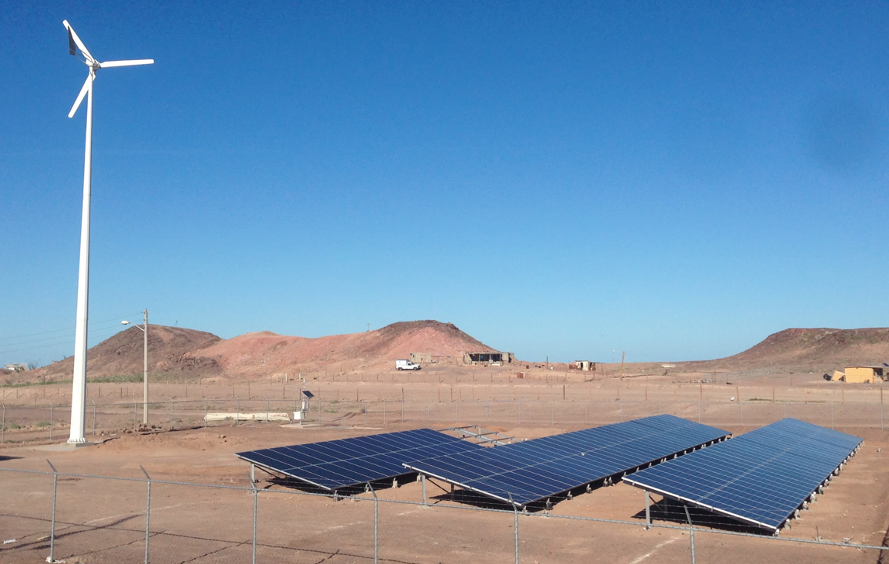Scientists from Mexico's National Institute of Electricity and Clean Energy have conducted a techno-economic feasibility study to assess the feasibility of integrating hydrogen-based power-to-gas-to-power (P2G2P) in a rural microgrid serving the Puertecitos community in the Mexican state of Baja California.
“The proposed system design can be replicated in different regions of Mexico and other latitudes,” researcher Tatiana Romero Castañon told pv magazine.
The incorporation of hydrogen would use excess renewable energy in winter for long-term storage, with the hydrogen facility consisting of an electrolyzer, a hydrogen tank, and a fuel cell system.
“The winter on the other hand, is very mild in this region of the country. Thus, there is no need to use any heating devices,” the scientists said.
In the proposed system configuration, which was modeled with Homer Pro software, the electricity generated by the microgrid's PV and wind installations is used for the microgrid's load demand and hydrogen generation through the electrolyzer. The microgrid consists of a 54.4kW photovoltaic system, a 60kW diesel generator, a 5kW wind turbine, and a 522kWh storage system.
The economic analysis was made by calculating the levelized cost of energy (LCOE) of the microgrid before and after the incorporation of the hydrogen facility.
Popular content
“With LCOE, the incorporation of the Hydrogen storage system (P2G2P) into the microgrid can be analyzed as an alternative to reduce, and eventually substitute, diesel, storing hydrogen along the seasons,” said the scientists. “Puertecitos could be an optimal region for hydrogen applications because it has no access to the power grid, but also, the microgrid depends (in summer) on the diesel generation.”
Different scenarios were considered in the modeling, based on two main reference scenarios: a system with fuel cell capacities ranging from 3kW to 12kW, an electrolyzer capacity of between 6kW and 22kW, and a tank with a storage capacity between 2 kg and 8 kg. They also considered a system with fuel capacities between 5kW and 18kW, an electrolyzer capacity of 10kW to 38kW, and a hydrogen tank with capacity ranging from 10 kg and 40 kg.
Through their analysis, the academics found that the most cost-competitive scenario is offered by a combination of a 6kW fuel cell, a 6kW electrolyzer, and a 2kg hydrogen tank. They assumed a capex of $1,250/kW for the fuel cell, $1,250/kW for the electrolyzer, and $500/kg for the tank.
“The question remaining is whether the considered range of Capex technology will become a reality,” the scientists said. “The model showed that reducing in half the current capital cost of electrolyzers, fuel cells and hydrogen tanks, the P2G2P becomes competitive. For this scenario, mass production and short-term H2 technologies adoptions can reduce the time for being cost-competitive. Another way to accelerate H2 adoption might be a rise in diesel prices.”
They described the system design in “A techno-economic study for a hydrogen storage system in a microgrid located in baja California, Mexico. Levelized cost of energy for power to gas to power scenarios,” which was recently published in the International Journal of Hydrogen Energy.
This content is protected by copyright and may not be reused. If you want to cooperate with us and would like to reuse some of our content, please contact: editors@pv-magazine.com.



2 comments
By submitting this form you agree to pv magazine using your data for the purposes of publishing your comment.
Your personal data will only be disclosed or otherwise transmitted to third parties for the purposes of spam filtering or if this is necessary for technical maintenance of the website. Any other transfer to third parties will not take place unless this is justified on the basis of applicable data protection regulations or if pv magazine is legally obliged to do so.
You may revoke this consent at any time with effect for the future, in which case your personal data will be deleted immediately. Otherwise, your data will be deleted if pv magazine has processed your request or the purpose of data storage is fulfilled.
Further information on data privacy can be found in our Data Protection Policy.